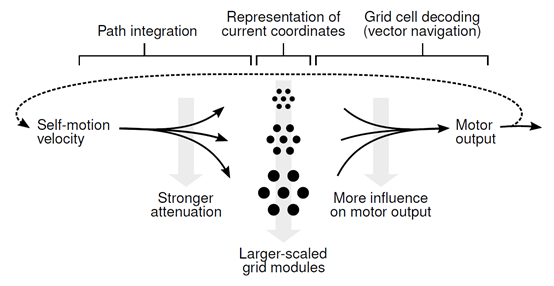
How to implement long-range navigation by path integration and decoding of grid cells in a neural network?
Edvardsen, Vegard. “Long-range navigation by path integration and decoding of grid cells in a neural network.” In 2017 International Joint Conference on Neural Networks (IJCNN), pp. 4348-4355. IEEE, 2017.
The following content is extracted from Edvardsen 2017.
Neural modelers in the domain of robot navigation, e.g. within the fields of neurorobotics and neuromorphic engineering, can benefit from a wealth of inspiration from neuroscientific research in the hippocampal formation—cell types such as place cells and grid cells provide a window into the inner workings of high-level cognitive processing, and have spawned many interesting computational models.
Grid cells are thought to participate in path integration and to implement a general coordinate system, both of which are useful features in a neural navigation model. Continuous attractor networks are a computational model that can embody both aspects of grid cells, and in previous work they showed that a neural network can successfully decode the outputs of such networks in order to implement vector navigation. That work assumes that the grid cell system represents long distances by employing a geometric progression in its spatial scaling of successive submodules, in such a way that “nested” grid cell decoding can be performed. For long-range navigation this requires that the continuous attractor networks can implement sufficiently long geometric progressions of grid scales, but this turns out to trigger the issue of “pinning”.
In this paper Edvardsen demonstrates conditions under which pinning occurs as well as its consequences for the grid cell-based navigation model. They propose and assess several candidate solutions to the problem, in particular based on differential adjustment of neurons’ update rates in the model. They finally demonstrate that the system is able to perform long-range navigation using our chosen solution.

Fig. 6 Self-motion velocity is used to update multiple CAN-based grid modules of increasing grid scales that follow a geometric progression. Larger grid scales are achieved by attenuating the input to the grid module, so that the module’s produced grid pattern appears stretched across space. The collective activity of all grid modules represents a set of “coordinates” in the navigation model. Larger-scaled grid modules are given priority in the decoding process, in accordance with the view that smaller-scaled grid modules are “nested”within the larger ones.
Fig from Edvardsen 2017.
For further info, please read the paper Edvardsen 2017.
Edvardsen, Vegard. “Long-range navigation by path integration and decoding of grid cells in a neural network.” In 2017 International Joint Conference on Neural Networks (IJCNN), pp. 4348-4355. IEEE, 2017.
About
Brain Inspired Navigation Blog
New discovery worth spreading on brain-inspired navigation in neurorobotics and neuroscience
Recent Posts
- How human, animals, robots encode and recall place?
- How the brain constructs time and space and how these are related to episodic memory?
- How environmental novelty modulate rapid cortical plasticity during navigation?
- How the Hippocampal Cognitive Map Supports Flexible Navigation?
- How the geometric structure and underlying circuit organization of hippocampal population dynamics facilitate both memory discrimination and generalization, enabling efficient and flexible learning?
Tags
Categories
- 3D Movement
- 3D Navigation
- 3D Path Integration
- 3D Perception
- 3D SLAM
- 3D Spatial Representation
- AI Navigation
- Bio-Inspired Robotics
- Brain Inspired Localization
- Brain-Inspired Navigation
- Cognitive Map
- Cognitive Navigation
- Episodic Memory
- Excerpt Notes
- Flying Vehicle Navigation
- Goal Representation
- Insect Navigation
- Learning to Navigate
- Memory
- Neural Basis of Navigation
- Path Integration
- Path Planning
- Project
- Research Tips
- Robotic Vision
- Self-Flying Vehicles
- Semantic Memory
- Spatial Cognition
- Spatial Cognitive Computing
- Spatial Coordinate System
- Spatial Learning
- Spatial Memory
- Spatial Resoning
- Time
- Unclassified
- Visual Cortex
- Visual Cue Cells
Links
- Laboratory of Nachum Ulanovsky
- Jeffery Lab
- BatLab
- The NeuroBat Lab
- Taube Lab
- Laurens Group
- Romani Lab
- Moser Group
- O’Keefe Group
- DoellerLab
- MilfordRobotics Group
- The Space and Memory group
- Angelaki Lab
- Spatial Cognition Lab
- McNaughton Lab
- Conradt Group
- The Fiete Lab
- The Cacucci Lab
- The Burak Lab
- Knierim Lab
- Clark Spatial Navigation & Memory Lab
- Computational Memory Lab
- The Dombeck Lab
- Zugaro Lab
- Insect Robotics Group
- The Nagel Lab
- Basu Lab
- Spatial Perception and Memory lab
- The Neuroecology lab
- The Nagel Lab
- Neural Modeling and Interface Lab
- Memory and Navigation Circuits Group
- Neural Circuits and Memory Lab
- The lab of Arseny Finkelstein
- The Epstein Lab
- The Theoretical Neuroscience Lab
- Gu Lab (Spatial Navigation and Memory)
- Fisher Lab (Neural Circuits for Navigation)
- The Alexander Lab (Spatial Cognition and Memory)
- Harvey Lab (Neural Circuits for Navigation)
- Buzsáki Lab
- Brain Computation & Behavior Lab
- ……